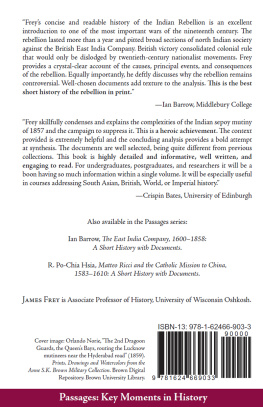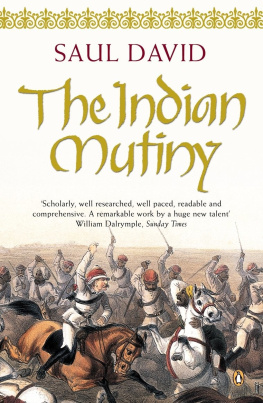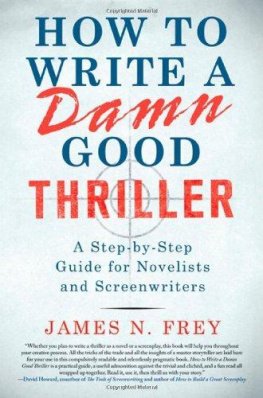CONTENTS
PASSAGES: KEY MOMENTS IN HISTORY
The Indian Rebellion,
18571859
A Short History with Documents
PASSAGES: KEY MOMENTS IN HISTORY
The Indian Rebellion,
18571859
A Short History with Documents
James Frey
Hackett Publishing Company, Inc.
Indianapolis/Cambridge
Though every reasonable effort has been made to contact the owners of the copyrighted materials included in this book, in some instances this has proven impossible. Hackett Publishing will be glad to receive information leading to a more complete understanding of the permissions required for this book and in the meantime extends its apologies for any omissions.
Copyright 2020 by Hackett Publishing Company, Inc.
All rights reserved
Printed in the United States of America
23 22 21 20 1 2 3 4 5 6 7
For further information, please address
Hackett Publishing Company, Inc.
P.O. Box 44937
Indianapolis, Indiana 46244-0937
www.hackettpublishing.com
Cover design by Rick Todhunter
Interior design by Laura Clark
Maps by Beehive Mapping
Composition by Aptara, Inc.
Library of Congress Control Number: 2020932115
ISBN-13: 978-1-62466-904-0 (cloth)
ISBN-13: 978-1-62466-903-3 (pbk.)
ePub3 ISBN: 978-1-62466-947-7
The Arthastra: Selections from the Classic Indian Work on Statecraft . Edited and Translated, with an Introduction, by Patrick Olivelle and Mark McClish.
Ian Barrow, The East India Company, 16001858: A Short History with Documents .
R. Po-chia Hsia, Matteo Ricci and the Catholic Mission to China, 15831610: A Short History with Documents .
The Nyya-stra: Selections with Early Commentaries . Translated, with Introduction and Explanatory Notes, by Matthew Dasti and Stephen Phillips.
Contents
The page numbers in curly braces {} correspond to the print edition of this title.
The Indian Rebellion was my gateway to the study of history. I wrote this book, in part, because I have always found this particular topic fascinating, as well as a good introduction to historiography and South Asian Studies. A close scrutiny of this book will reveal many scholars fingerprints: those of Eugene Irshick, Thomas R. Metcalf, Ronald Goldman, and George L. Hart, who first taught me about Indian civilization when I was an undergraduate at the University of California at Berkeley; and, from my graduate school days at the University of Wisconsin-Madison, those of Robert Eric Frykenberg, Andr Wink, and many others. In graduate school, I was able to pursue my interest in the East India Company, its sepoy armies, and the dynamics of mutiny in a colonial context. Under my premarital name, Hoover, my PhD dissertation was published by Manohar and titled Men Without Hats: Dialogue, Discipline, & Discontent in the Madras Army, 18061807 (2007). Later, I contributed to Dr. Crispin Batess Mutiny at the Margins project. In recent years, my work has focused on Indian maritime history and lascars, as well as different aspects of trade (especially saltpeter and cochineal), and the rise of nineteenth-century globalization. All these threads of inquiry, however, have in one way or another intersected with the Indian Rebellion, and their traces can be found in this work.
I wish to acknowledge my wife, Heidi Frey, who visited Delhi, Lucknow, and Calcutta with me during a recent trip to India, and who helped me stay focused and productive during the writing of this book. I also want to thank the students in my class on the Indian Rebellion, who used the primary sources presented here, as well as part of the first draft of the narrative, and offered me enthusiastic support and advice. Finally, I am indebted to my departmentto colleagues who have established a strong record of research and writing, and an atmosphere that encourages this kind of scholarly pursuit.
Events Prior to 1857 |
1600 | The first English Company is chartered to trade with Asia |
1709 | The East India Company (EIC) created by the merger of two firms |
1757 | Battle of Plassey |
1765 | The EIC becomes a territorial power in India |
1774 | Warren Hastings is first governor-general, pursues goal of Paramountcy |
1784 | Pitts India Act creates the Board of Control |
1793 | Permanent Settlement in Bengal |
1813 | Charter Act abolishes the EICs Indian monopolies; opens India to free trade and Protestant missionaries |
1824 | First Barrackpur mutiny |
1833 | Charter Act abolishes the EICs China trade monopoly |
1842 | Defeat of the EICs army at Kabul |
1843 | Bengal Army troops refuse to march to Sind |
1848 | Lord Dalhousie begins systematic use of Doctrine of Lapse |
1850 | Batta crisis after the annexation of Punjab |
1851 | Nana Sahib is denied the inheritance of Bajirao IIs stipend |
1853 | Jhansi is annexed under the Doctrine of Lapse; Charter Act exerts greater Crown authority over EIC |
1854 | Nagpur is annexed under the Doctrine of Lapse |
1856 | Annexation of Awadh; General Service Enlistment Act; the EIC sends expeditions to Persia and China |
Events of 1857 |
January | First signs of sepoy unrest regarding Enfield cartridges |
February 26 | Sepoy protests at Berhampur |
March 29 | Mutiny of Mangal Pandey at Barrackpur |
April 8 | Hanging of Mangal Pandey |
May 10 | Mutiny at Meerut |
May 11 | Mutiny at Delhi |
May 13 | Bahadur Shah Zafar II declared emperor at Delhi |
May 30 | Mutinies at Lucknow and Muttra |
June 5 | Mutiny at Kanpur |
June 6 | Siege of Wheelers Entrenchment at Kanpur begins; mutiny at Allahabad |
June 8 | Battle of Badli-ki-Sarai; massacre at Jhansi |
June 27 | Sati Chaura Ghat massacre at Kanpur |
June 30 | Battle of Chinhat; siege of Lucknow Residency begins |
July 1 | Mutiny at Indore in Central India |
July 12 | Havelock defeats rebels at Fatehpur |
July 15 | Bibigarh massacre at Kanpur |
July 16 | Havelocks force marches into Kanpur |
August 1 | Massacre of sepoy prisoners at Ajnala, Punjab |
September 4 | Siege Train from Punjab arrives at Delhi |
September 14 | Storming of Delhi; 6-day battle for city begins |
September 21 | Hodson arrests Bahadur Shah II |
September 22 | Hodson executes the Mughal princes |
September 25 | First Relief of Lucknow |
November 14 |











